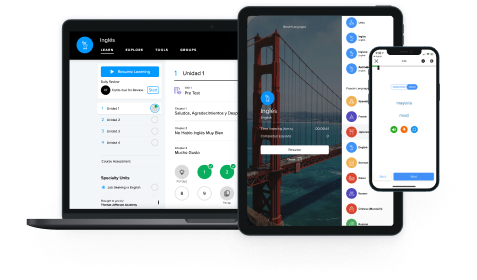In German, two-case prepositions are prepositions that can trigger either the accusative case or the dative case, depending on how they are being used. There are nine two-case prepositions in the German language, all of which follow the rule below:
Use the dative case when they describe location:
dative case
Die Hunde rennen im Garten herum.
The dogs are running in the yard.
→ The whole action happens in a single location: the yard. (im = in + dem)
Use the accusative case when they describe a direction:
accusative case
Die Hunde rennen in den Garten.
The dogs are running into the yard.
→ They yard is a destination or direction: they move to the yard.
It’s a pretty simple rule, and nine prepositions doesn’t sound that bad, does it? Nope! But you still have to learn them! Let’s have a closer look.
When to use dative vs. accusative with two-case prepositions?
As you’ve just read above, German two-case prepositions take the accusative case when they describe a direction of motion and the dative case when they describe a location.
Direction → accusative case
Location → dative case
Let’s look at some examples using the two-case prepositions hinter(behind) and unter(under).
accusative Der Hund rennt schnell hinter das Sofa. The dog is running quickly behind the couch. | dative Der hechelnde Hund sitzt hinter dem Sofa. The panting dog is sitting behind the couch. |
accusative Die Bälle rollen unter den Tisch. The balls are rolling under the table. | dative Die Hunde finden die Bälle unter dem Tisch. The dogs are finding the balls under the table. |
Quick quiz! Can you guess the correct case that will follow the preposition in(in, into) in the following sentences?
The car is in the garage.
The car is driving into the garage.
Ready for the answer? Here are your sentences!
dative
Das Auto steht in der Garage.
The car is in the garage.
→ a location
accusative
Das Auto fährt in die Garage.
The car is driving into the garage.
→ movement from A to B
Remember that the presence of a movement verb like rennen(to run) alone is not enough to trigger the accusative case!
It has to be a sentence describing movement point A to point B, where point B follows the preposition. If all the movement takes place at point B, you’ll use the dative. Compare:
accusative Der Hund rennt vom Haus auf den Rasen. The dog is running from the house to the lawn. | dative Der Hund rennt auf dem Rasen. The dog is running on the lawn. |
Here are a couple more helpful points to remember.
Location vs. direction: ‘wo’ and ‘wohin’
The German equivalents of the question word “where” distinguish between whether we’re asking for a location, wo(at where), or a direction wohin(to where). So you can ask yourself which question you’d use as a way to decide what case should follow the preposition:
dative
Speaker A:Where is the dog playing?
Speaker B:Der Hund spielt in der Sonne mit dem Ball.
The dog is playing with the ball in the sun.
accusative
Speaker A:Where are the pears falling?
Speaker B:Die Birnen fallen vom Baum auf den Boden.
The pears are falling from the tree onto the ground.
Location vs. direction: Verbs
While you often have to pay attention to the context, there are also several verbs in the German language that differentiate between location or a direction. The most common ones are illustrated below:
liegen(to lay) | legen(to put) |
sitzen(to sit, be seated) | setzen(to sit down, to put) |
stehen(to stand) | stellen(to put) |
hängen(to hang) | hängen(to hang something) |
When you find a two-case preposition used with one of these verbs, the verb itself can give you a hint about which case is required!
accusative
Der Mann setzt seinen Hund auf die Parkbank.
The man is sitting his dog on the park bench.
→ The dog was not on the park bench, and now he is.
dative
Der Mann sitzt mit seinem Hund auf der Parkbank.
The man is sitting on the park bench with his dog.
→ The man remains on the park bench, where he was already.
Check out our post on location vs. direction verbs in German to learn more about the verbs in the table above!
What are the two-case prepositions in German?
In German, the two-case prepositions are an(on, onto), auf(on top of), hinter(behind), in(in, into), neben(next to), über(over), unter(under), and vor(in front of, by). Additionally, though the preposition entlang(along, alongside) isn’t really a two-case preposition, it has some uses that make it similar.
Remember, that like all prepositions, the exact translations of these words can be quite flexible, and they may have a range of meanings. For example, the two-case preposition über can loosely translate to “across,” “over,” or “above,” but it can also be used to mean “about” when you’re saying that you’re “talking about” something. So be sure to always also look at the context!
Let’s look at some examples!
‘an’ (on, onto)
accusative
Der Hundebesitzer hängt die Hundeleine an den Haken.
The dog owner hangs the dog leash on the hook.
dative
Die Hundeleine hängt jetzt am Haken.
The dog leash is now hanging on the hook.
→ am = an + dem(the (dative))
‘auf’ (on top of)
accusative
Der Frosch springt auf den Stein.
The frog is jumping on the rock.
dative
Der Frosch sitzt jetzt auf dem Stein.
The frog is now sitting on the rock.
‘hinter’ (behind)
accusative
Der Lehrer legt seine Tasche hinter den Schreibtisch.
The teacher is laying his bag behind the desk.
dative
Die Tasche befindet sich nun hinter dem Schreibtisch.
The bag is now behind the desk.
‘in’ (in, into)
accusative
Das Kind lockte den Hund in das Zimmer.
The child lured the dog into the room.
dative
Das Kind und der Hund spielten dann zusammen im Zimmer.
The child and the dog then played in the room together.
→ im = in + dem(the (dative))
‘neben’ (next to)
accusative
Der Apfel fällt neben den Apfelbaum.
The apple is falling next to the apple tree.
dative
Neben dem Apfelbaum tobt eine kleine rote Katze.
Next to the apple tree a little red cat is frolicking.
‘über’ (over, above)
accusative
Die Vögel fliegen über die Wolken.
The birds are flying over the clouds.
dative
Über den Wolken muss die Freiheit wohl grenzenlos sein.
Above the clouds freedom must be endless.
‘unter’ (under)
accusative
Der Roboter-Staubsauger fährt unter den Schrank.
The robot vacuum cleaner is going under the cupboard.
dative
Unter dem Schrank liegt ganz viel Staub.
Under the cupboard is a lot of dust.
‘vor’ (in front of, by)
accusative
Der Lieferant stellt das Paket vor die Tür.
The delivery man puts the package in front of the door.
dative
Als die Frau nach Hause kam, wartete ihr Vater schon vor der Tür.
When the woman came home, her father was already waiting by the door.
‘zwischen’ (between)
accusative
Die Mutter stellte die Vase zwischen die Kuchenplatte und die Kaffeekanne.
The mother put the vase between the cake platter and the coffee pot.
dative
Die Mutter stellte die Vase zwischen dem Käsekuchen und dem Marmorkuchen.
The poppyseed cake was in between the cheesecake and the marble cake.
Is ‘entlang’ a two-case preposition in German?
In German, the word entlang(along, alongside) is not a two-case preposition, but it can be used to describe location and direction, and it can also be used before more than one case.
The preposition entlang usually takes the genitive case. However, in colloquial speech it can sometimes be used with the dative case.
genitive
Die Frau geht mit ihrem Hund entlang des Flusses spazieren.
The woman is taking a walk with her dog along the river.
dative
Die Frau geht mit ihrem Hund entlang dem Fluss spazieren.
The woman is taking a walk with her dog along the river.
Entlang can also trigger the accusative case, but this only happens when it is used as a postposition (meaning it comes after the noun it modifies).
accusative
Die Frau geht mit ihrem Hund den Fluss entlang.
The woman is taking a walk with her dog along the river.
The use of the accusative with entlang has everything to do with the position of the preposition, and nothing to do with whether it’s used as a location or a direction.

